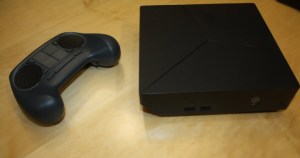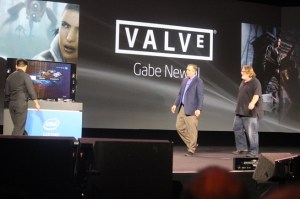Valve is normally a company with many secrets. But company CEO Gabe Newell held a press conference this week at the 2014 International CES and then appeared on stage at the keynote speech of Intel chief executive Brian Krzanich — all to talk about Steam Machines, living room machines for gamers.
The announcement was impressive, but it exposed a lot of contradictions that arise when you create a new gaming platform at a time when it is very hard to break away from other ecosystems and create something from scratch.
Valve said it was designing a Linux-based Steam OS, a Steam Controller for playing mouse-and-keyboard games in the living room, and it was partnering with 14 companies to build Steam Machines that would go head to head with Windows gaming PCs and consoles. That speaks to Valve’s power.
But it raised a lot of questions for me. Is Valve crazy? Is Valve powerful? Is Valve closed? Is Valve open? The answer to all of those questions, in my opinion, is yes.
Valve has a reputation for taking care of its community, which consists of fans of its games like Half-Life and Left 4 Dead and the 65 million customers who buy games through Valve’s Steam digital distribution service. That service has increasingly become identified with the heart and soul of PC gaming as Microsoft puts more emphasis on its console game business and its Xbox Live online gaming service.
Newell said that Valve does things that its community wants. That community wanted to be able to play PC games in the living room without having to buy a new set of machines and subscribe to new services. A few years ago, Newell said Valve became “worried” that the PC was becoming more closed.
Chief among those worries — left unsaid by Newell — was that Microsoft might make it hard to access the Steam store on Windows 8 and beyond. There was too much “friction” that was making life harder for Steam customers, said Valve Steam Machines designer Greg Coomer.
If Microsoft went in this direction, it would just be following in the footsteps of Apple, which favors its iTunes App Store on mobile devices. Apple tolerates some stores, like Netflix or Amazon, because consumers really want them on their mobile devices.
So this whole Steam effort got started out of a fear that the PC would become “closed.” Valve says it is acting to protect consumers. And you could argue that gamers trust Valve more than they trust Microsoft at this point.
But that doesn’t mean Valve is open. For instance, the Steam Machine partners can’t do anything they want. For now, to be able to call their gamer computers “Steam Machines,” they have to use the Steam OS and the Steam Controller. They can’t ship a Steam Machine before the Steam Controller is available and finalized, and that will be later this year.
The Steam Controller is a great innovation, making it possible to play mouse-and-keyboard games on the TV. But it is also a point of control. The makers of Steam Machines have to listen to Valve before they go off and do their own thing. This suggests that while Valve may be more open than Microsoft, and while Valve operates with the best interests of consumers in mind, Valve is still closed.
It is impressive that Newell appeared on stage with the CEO of Intel, and that Nvidia CEO Jen-Hsun Huang attended Valve’s event. It is also impressive that so many partners have stepped forward, risking the wrath of Microsoft.
But Valve is also crazy. It has been working on this project for a while, and it is moving in slow motion. The company has just 300 employees, most of them working on games. In fact, Valve had a layoff last year. And it leaked word that it was working on virtual reality goggles, akin to the Oculus VR goggles.
Yet the VR effort is a parallel effort, said Anna Sweet, another Steam Machine leader at Valve. The two projects aren’t exactly linked.
This strikes me as strange, as both projects probably require huge resources. Microsoft launched the Xbox back in 2001 — its first major foray into console games — with something like 2,000 employees. Valve is evidently doing its work on projects like the Steam OS with a handful of people.
Coomer suggested that because Valve has been including Steam Machine features in the Steam service — like the Big Picture update that allows you to play Steam games on the TV, that it doesn’t take as many resources to churn out Steam Machines. Plus, hardware makers will build the Steam Machines.
But there are mysteries among the Steam Machines. Word of a possible “Steam Box” surfaced last year as Xi3, a maker of small form factor gaming PCs, acknowledged that it had received an investment from Valve. The year went by without a launch of the Steam devices, and then Microsoft and Sony launched their consoles.
And when the Steam Machines announcement came, Xi3 wasn’t represented. Xi3’s chief marketing officer, David Politics, told me this week that they didn’t have a Steam Machine to announce. In fact, he said that Xi3’s strategy had “diverged” from Valve’s when it came to Steam Machines. His company makes both Windows and Linux machines. But Xi3 believes that a Windows-based Steam Machine might be a better alternative (Now what would that be?). Politis wishes Valve well, but he isn’t yet ready to get into this fight, which appears to be between Valve and Microsoft.
Consoles — and the game development and publishing ecosystems that go with them — are a very difficult thing to get off the ground. They require a lot of help from partners, but those partners won’t help unless they are guaranteed a lot of information. Right now, Valve hasn’t said enough.
After almost a year of silence, Newell spoke on Monday night for about 10 minutes. He spoke for an even shorter time about Steam Machines at Intel’s keynotes. That’s not what I would call over-communication. Nvidia similarly hasn’t said much about the launch of its Android-based Shield portable gaming device, and consequently, it isn’t getting much attention, and it isn’t getting noticed by consumers.
If Valve wants the Steam Machines to take off, it’s going to need a huge marketing campaign. I don’t see that happening. We’ll see if anything changes between now and the second half of the year, when Steam Machines are expected to launch.
Here are a few questions: Is Valve going to spend a lot of money on marketing? Is Valve trying to act on behalf of consumers, or is it trying to protect its Steam store revenues? Will Valve support machines that partners create that have both Windows and Steam operating systems? How will it hope to compete with the PlayStation 4 and the Xbox One? Is Microsoft closing off the PC?
And here’s a request: Openness starts with being open with the press. And given what is involved in educating the public about games, I hope Valve will step up its game.
VentureBeat's mission is to be a digital town square for technical decision-makers to gain knowledge about transformative enterprise technology and transact. Learn More





